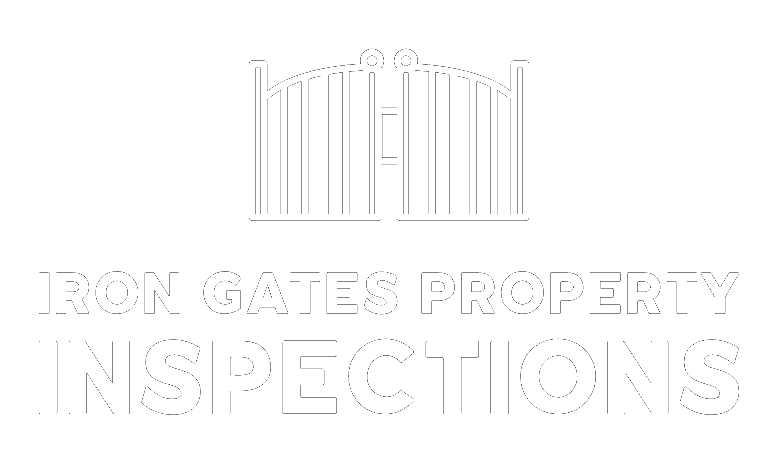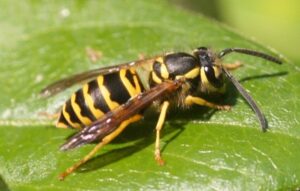 Yellow jackets are one of the most common and feared pests, especially during late summer and early fall. While they often get a bad rap, they’re also fascinating insects with some interesting behaviors. Here are some facts you can use for your blog post to give your readers a comprehensive look at these “wasps with an attitude.”
Yellow jackets are one of the most common and feared pests, especially during late summer and early fall. While they often get a bad rap, they’re also fascinating insects with some interesting behaviors. Here are some facts you can use for your blog post to give your readers a comprehensive look at these “wasps with an attitude.”
The Basics: What is a Yellow Jacket? 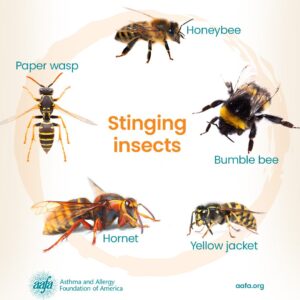
They aren’t bees: A common misconception is that yellow jackets are a type of bee. They’re actually a species of social wasp. You can tell the difference by their appearance: yellow jackets have sleek, hairless bodies and a distinctive thin waist, while bees are generally more plump and fuzzy.
Nesting and Colony Life
Social insects: Yellow jackets live in large, annual colonies with a queen, workers, and male drones. A single colony can grow to contain thousands of individuals by the end of the summer.
Where they build nests: 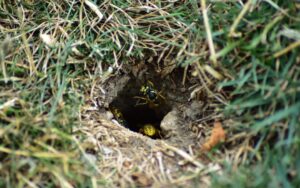
- Underground: They frequently use abandoned rodent burrows or other cavities in the ground. This is particularly dangerous for humans, as an in-ground nest can be accidentally disturbed by lawnmowers or foot traffic.
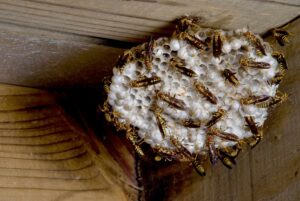
- Aerial locations: They also build nests in bushes, trees, under the eaves of houses, in attics, wall voids, and even inside old furniture.
In the late summer and early fall, as natural food sources decline, yellow jackets become more desperate for sugar. This is why they are so persistent and aggressive at picnics, outdoor barbecues, and around trash cans.
- The Dangers of Yellow Jackets
Multiple stings: Unlike honeybees, which have barbed stingers and can only sting once, yellow jackets have a smooth stinger that allows them to sting repeatedly without dying. - Defensive nature: Yellow jackets are highly protective of their nests. If they feel threatened, they will swarm and attack in coordinated waves. They even release an alarm pheromone that signals other wasps to join the attack.
- Allergic reactions: For individuals with allergies, a yellow jacket sting can cause a severe or even life-threatening reaction called anaphylactic shock.
Don’t DIY: Because of their aggressive nature and the risk of multiple stings, it’s generally not recommended to try to remove a yellow jacket nest yourself. Disturbing the nest can lead to a painful and dangerous encounter.
How to Safely and Effectively Get Rid of a Yellow Jacket Nest
Yellow jackets are notorious for their aggressive nature and painful, repeated stings. Finding a nest near your home can be unnerving. While a professional exterminator is the safest and most recommended option, especially for large or hard-to-reach nests, you can take on the task yourself with the right precautions.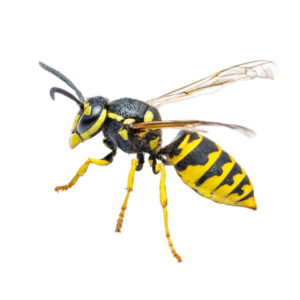
Safety First: The Golden Rules
Before you even think about treating the nest, remember these critical safety guidelines:
- Go at Night: Yellow jackets are least active and all inside the nest after dark. This is the only safe time to approach.
- Avoid Direct Light: Don’t use a flashlight pointed at the nest entrance. The light can agitate them and trigger an attack.
- Gear Up: Wear heavy-duty clothing, gloves, and a hat with a face veil. The more you’re covered, the better.
- Never Block the Entrance: Sealing the nest entrance is a mistake. It won’t kill them; it will only force them to find another way out, potentially into your house.
Effective DIY Methods
With your safety gear on and the sun down, you can choose a method to destroy the nest.
1. Insecticide Sprays & Dusts
Aerosol Sprays: Purchase a hornet and wasp spray with a long-range jet. Stand back and spray directly into the nest entrance. The powerful stream allows you to maintain a safe distance.
Insecticide Dust: Dust is highly effective for nests in the ground or inside walls. Puff the powder into the nest entrance at night. The yellow jackets will carry the dust inside, spreading it throughout the colony and killing the queen and larvae. This method is often preferred by professionals for hard-to-reach nests because the dust penetrates deeper than a liquid spray.
2. The Soapy Water Method
For a non-toxic option, a simple mix of soap and water can work wonders. The soap breaks the surface tension of the water, causing the liquid to suffocate the insects by clogging their breathing pores.
How to Use: Mix a generous amount of dish soap with water in a large bucket. For ground nests, carefully pour the solution directly into the hole. Be prepared to move quickly and retreat immediately.
3. Diatomaceous Earth (DE)
This organic powder is made from fossilized algae. It’s a natural pest control solution that is safe for people and pets.
How to Use: Apply a light layer of food-grade diatomaceous earth to the nest entrance. When the yellow jackets walk over the powder, it cuts their exoskeletons, causing them to dehydrate and die.
4. Use Peanut Butter As Bait to Attract Predators
There is an interesting, though unproven, theory that placing peanut butter near a ground nest can attract predators like raccoons, skunks, or opossums. These animals are known to eat yellow jacket larvae and may be attracted to the peanut butter bait, leading them to discover the nest and destroy it.
Because yellow jackets do not produce or store honey one might wonder why striped skunks, raccoons and black bears frequently dig up their underground nests. It is the young yellow jackets (larvae), not honey, that is so highly prized by these insect-eating predators. At this time of year it is crucial for them, especially black bears who go for months without eating or drinking during hibernation, to consume enough protein to survive the winter.
While these methods can be effective, some situations are best left to the experts.
The nest is large. A huge, established colony is too dangerous to tackle on your own.
The nest is in a difficult location, like inside a wall void or high up under the eaves. Professionals have the right equipment and experience to handle these without causing further damage.
You are allergic to stings. A single sting could lead to a life-threatening reaction.
Remember, a yellow jacket nest is not something to be taken lightly. By prioritizing safety and choosing the right method for the job, you can successfully reclaim your yard from these pests.
